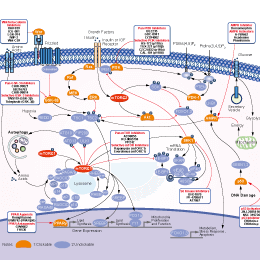
- Bioactive Compounds
- By Signaling Pathways
- PI3K/Akt/mTOR
- Epigenetics
- Methylation
- Immunology & Inflammation
- Protein Tyrosine Kinase
- Angiogenesis
- Apoptosis
- Autophagy
- ER stress & UPR
- JAK/STAT
- MAPK
- Cytoskeletal Signaling
- Cell Cycle
- TGF-beta/Smad
- DNA Damage/DNA Repair
- Compound Libraries
- Popular Compound Libraries
- Customize Library
- Clinical and FDA-approved Related
- Bioactive Compound Libraries
- Inhibitor Related
- Natural Product Related
- Metabolism Related
- Cell Death Related
- By Signaling Pathway
- By Disease
- Anti-infection and Antiviral Related
- Neuronal and Immunology Related
- Fragment and Covalent Related
- FDA-approved Drug Library
- FDA-approved & Passed Phase I Drug Library
- Preclinical/Clinical Compound Library
- Bioactive Compound Library-I
- Bioactive Compound Library-Ⅱ
- Kinase Inhibitor Library
- Express-Pick Library
- Natural Product Library
- Human Endogenous Metabolite Compound Library
- Alkaloid Compound LibraryNew
- Angiogenesis Related compound Library
- Anti-Aging Compound Library
- Anti-alzheimer Disease Compound Library
- Antibiotics compound Library
- Anti-cancer Compound Library
- Anti-cancer Compound Library-Ⅱ
- Anti-cancer Metabolism Compound Library
- Anti-Cardiovascular Disease Compound Library
- Anti-diabetic Compound Library
- Anti-infection Compound Library
- Antioxidant Compound Library
- Anti-parasitic Compound Library
- Antiviral Compound Library
- Apoptosis Compound Library
- Autophagy Compound Library
- Calcium Channel Blocker LibraryNew
- Cambridge Cancer Compound Library
- Carbohydrate Metabolism Compound LibraryNew
- Cell Cycle compound library
- CNS-Penetrant Compound Library
- Covalent Inhibitor Library
- Cytokine Inhibitor LibraryNew
- Cytoskeletal Signaling Pathway Compound Library
- DNA Damage/DNA Repair compound Library
- Drug-like Compound Library
- Endoplasmic Reticulum Stress Compound Library
- Epigenetics Compound Library
- Exosome Secretion Related Compound LibraryNew
- FDA-approved Anticancer Drug LibraryNew
- Ferroptosis Compound Library
- Flavonoid Compound Library
- Fragment Library
- Glutamine Metabolism Compound Library
- Glycolysis Compound Library
- GPCR Compound Library
- Gut Microbial Metabolite Library
- HIF-1 Signaling Pathway Compound Library
- Highly Selective Inhibitor Library
- Histone modification compound library
- HTS Library for Drug Discovery
- Human Hormone Related Compound LibraryNew
- Human Transcription Factor Compound LibraryNew
- Immunology/Inflammation Compound Library
- Inhibitor Library
- Ion Channel Ligand Library
- JAK/STAT compound library
- Lipid Metabolism Compound LibraryNew
- Macrocyclic Compound Library
- MAPK Inhibitor Library
- Medicine Food Homology Compound Library
- Metabolism Compound Library
- Methylation Compound Library
- Mouse Metabolite Compound LibraryNew
- Natural Organic Compound Library
- Neuronal Signaling Compound Library
- NF-κB Signaling Compound Library
- Nucleoside Analogue Library
- Obesity Compound Library
- Oxidative Stress Compound LibraryNew
- Plant Extract Library
- Phenotypic Screening Library
- PI3K/Akt Inhibitor Library
- Protease Inhibitor Library
- Protein-protein Interaction Inhibitor Library
- Pyroptosis Compound Library
- Small Molecule Immuno-Oncology Compound Library
- Mitochondria-Targeted Compound LibraryNew
- Stem Cell Differentiation Compound LibraryNew
- Stem Cell Signaling Compound Library
- Natural Phenol Compound LibraryNew
- Natural Terpenoid Compound LibraryNew
- TGF-beta/Smad compound library
- Traditional Chinese Medicine Library
- Tyrosine Kinase Inhibitor Library
- Ubiquitination Compound Library
-
Cherry Picking
You can personalize your library with chemicals from within Selleck's inventory. Build the right library for your research endeavors by choosing from compounds in all of our available libraries.
Please contact us at info@selleckchem.com to customize your library.
You could select:
- Antibodies
- Bioreagents
- qPCR
- 2x SYBR Green qPCR Master Mix
- 2x SYBR Green qPCR Master Mix(Low ROX)
- 2x SYBR Green qPCR Master Mix(High ROX)
- Protein Assay
- Protein A/G Magnetic Beads for IP
- Anti-Flag magnetic beads
- Anti-Flag Affinity Gel
- Anti-Myc magnetic beads
- Anti-HA magnetic beads
- Poly DYKDDDDK Tag Peptide lyophilized powder
- Protease Inhibitor Cocktail
- Protease Inhibitor Cocktail (EDTA-Free, 100X in DMSO)
- Phosphatase Inhibitor Cocktail (2 Tubes, 100X)
- Cell Biology
- Cell Counting Kit-8 (CCK-8)
- Animal Experiment
- Mouse Direct PCR Kit (For Genotyping)
- New Products
- Contact Us
research use only
Vistusertib (AZD2014) mTOR inhibitor
A novel mTOR inhibitor with IC50 of 2.8 nM in a cell-free assay, Vistusertib (AZD2014) is highly selective against multiple PI3K isoforms (α/β/γ/δ). It showed no or weak binding to the majority of kinases when tested at 1 μM. This compound induces proliferation suppression, apoptosis, cell cycle arrest, and autophagy in HCC cells with antitumor activity.
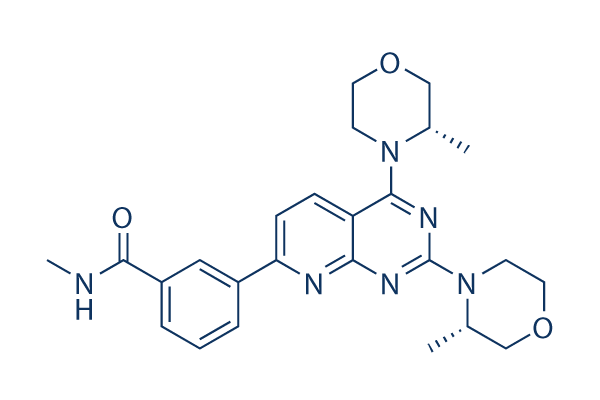
Chemical Structure
Molecular Weight: 462.54
Purity & Quality Control
Batch:
Purity:
99.70%
99.70
Related Products
| Related Targets | mTORC1 mTORC2 | Click to Expand |
|---|---|---|
| Related Products | AZD8055 Torin 1 Ridaforolimus (Deforolimus, MK-8669) Sapanisertib (MLN0128) Torkinib (PP242) MHY1485 KU-0063794 Torin 2 OSI-027 WYE-354 WYE-125132 (WYE-132) 3BDO Palomid 529 (P529) Zotarolimus (ABT-578) Salidroside GDC-0349 WAY-600 Onatasertib (CC 223) XL388 WYE-687 | Click to Expand |
| Related Compound Libraries | Kinase Inhibitor Library PI3K/Akt Inhibitor Library Apoptosis Compound Library Cell Cycle compound library NF-κB Signaling Compound Library | Click to Expand |
Signaling Pathway
Cell Culture and Working Concentration
| Cell Lines | Assay Type | Concentration | Incubation Time | Formulation | Activity Description | PMID |
|---|---|---|---|---|---|---|
| HEK293 | Function assay | Inhibition of recombinant FLAG-tagged mTOR (1362 to 2549) (unknown origin) expressed in HEK293 cells, IC50 = 0.0028 μM. | 23375793 | |||
| MDA-MB-468 | Function assay | 2 hrs | Inhibition of mTORC2 in human MDA-MB-468 cells assessed as reduction of AKT phosphorylation at Ser473 after 2 hrs, IC50 = 0.08 μM. | 23375793 | ||
| MDA-MB-468 | Function assay | 2 hrs | Inhibition of mTORC1 in human MDA-MB-468 cells assessed as reduction of pS6 phosphorylation at Ser235/236 after 2 hrs, IC50 = 0.2 μM. | 23375793 | ||
| MCF7 | Function assay | Inhibition of mTORC2 in human MCF7 cells xenografted mouse assessed as modulation substrate | 23375793 | |||
| MCF7 | Function assay | Inhibition of mTORC1 in human MCF7 cells xenografted mouse assessed as modulation substrate | 23375793 | |||
| MCF7 | Cytotoxicity assay | 5 days | Cytotoxicity against human MCF7 cells after 5 days by Presto blue reagent-based fluorescence analysis | ChEMBL | ||
| Click to View More Cell Line Experimental Data | ||||||
Mechanism of Action
| Targets |
|
|---|
In vitro |
||||
| In vitro | Vistusertib (AZD2014) is a close analogue of AZD8055 and a selective inhibitor of mTOR kinase. It has greater inhibitory activity against mTORC1 compared to rapamycin: this compound decreases p4EBP1 Thr37/46, inhibits the translation initiation complex and decreases overall protein synthesis while rapamycin has no effect. It also inhibits the mTORC2 biomarkers pAKTSer473 and pNDRG1Thr346. AZD2014 has broad antiproliferative activity across multiple tumour cell lines. In particular, it induces growth inhibition and cell death in breast cancer cell lines, including ER+ cell lines with acquired resistance to hormone therapy. [1] |
|||
|---|---|---|---|---|
| Experimental Result Images | Methods | Biomarkers | Images | PMID |
| Western blot | p-4EBP1 / 4EBP1 / p-S6K / S6K / p-AKT S473 / AKT p-mTOR(S2448) / mTOR / p-S6(235/236) / S6 |
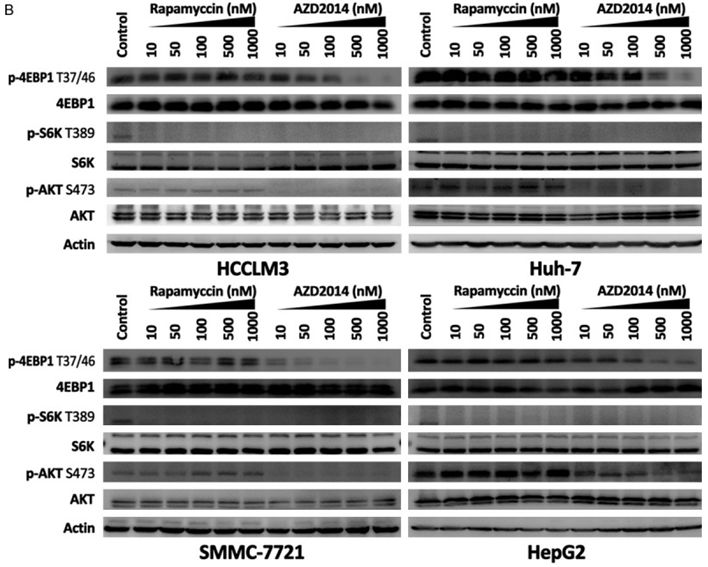
|
25628925 | |
| Immunofluorescence | E-cadherin / Vimentin |
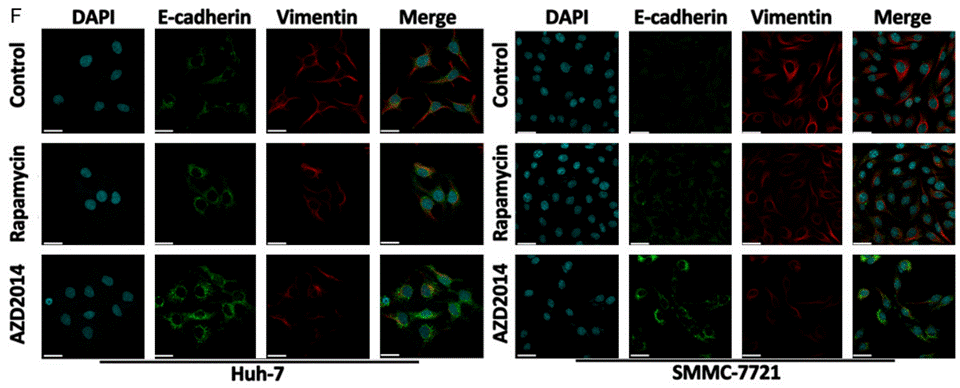
|
25628925 | |
| Growth inhibition assay | Cell viability |
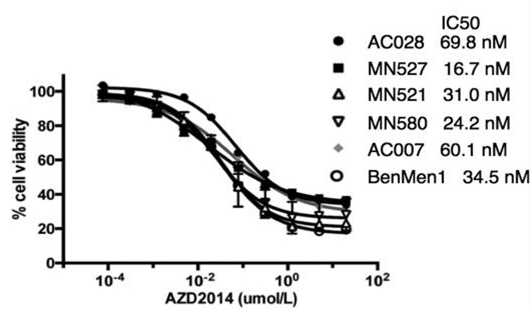
|
26219339 | |
In Vivo |
||
| In vivo | Vistusertib (AZD2014) induces tumour growth inhibition against several xenograft models including a human primary explant model of ER+ breast cancer. This antitumour activity is associated with modulation of both mTORC1 and mTORC2 substrates. [1] |
|
|---|---|---|
| Animal Research | Animal Models | Male SCID mice |
| Dosages | 20 mg/kg | |
| Administration | p.o. | |
| NCT Number | Recruitment | Conditions | Sponsor/Collaborators | Start Date | Phases |
|---|---|---|---|---|---|
| NCT02619864 | Completed | Glioblastoma Multiforme |
Canadian Cancer Trials Group|AstraZeneca |
December 22 2016 | Phase 1 |
| NCT02780830 | Withdrawn | Core: Relapsed or Refractory Diffuse Large B-Cell Lymphoma|Module 1: Non-GCB Diffuse Large B-Cell Lymphoma |
AstraZeneca |
June 2016 | Phase 1 |
| NCT02730923 | Active not recruiting | Endometrial Carcinoma|Metastatic Carcinoma|Hormone Receptor Positive Tumor |
Centre Leon Berard |
April 2016 | Phase 1|Phase 2 |
| NCT02599714 | Completed | Advanced and Metastatic Breast Cancer |
AstraZeneca |
December 7 2015 | Phase 1 |
| NCT02752204 | Completed | Diffuse Large B-Cell Lymphoma |
University of Birmingham|Bloodwise|AstraZeneca|Cancer Research UK |
October 2015 | Phase 2 |
References |
|
Chemical Information
| Molecular Weight | 462.54 | Formula | C25H30N6O3 |
| CAS No. | 1009298-59-2 | SDF | Download SDF |
| Synonyms | N/A | ||
| Smiles | CC1COCCN1C2=NC(=NC3=C2C=CC(=N3)C4=CC(=CC=C4)C(=O)NC)N5CCOCC5C | ||
Storage and Stability
| Storage (From the date of receipt) | |||
|
In vitro |
DMSO : 92 mg/mL ( (198.9 mM) Moisture-absorbing DMSO reduces solubility. Please use fresh DMSO.) Water : Insoluble Ethanol : Insoluble |
Molecular Weight Calculator |
|
In vivo Add solvents to the product individually and in order. |
In vivo Formulation Calculator |
|||||
Preparing Stock Solutions
Molarity Calculator
In vivo Formulation Calculator (Clear solution)
Step 1: Enter information below (Recommended: An additional animal making an allowance for loss during the experiment)
mg/kg
g
μL
Step 2: Enter the in vivo formulation (This is only the calculator, not formulation. Please contact us first if there is no in vivo formulation at the solubility Section.)
% DMSO
%
% Tween 80
% ddH2O
%DMSO
%
Calculation results:
Working concentration: mg/ml;
Method for preparing DMSO master liquid: mg drug pre-dissolved in μL DMSO ( Master liquid concentration mg/mL, Please contact us first if the concentration exceeds the DMSO solubility of the batch of drug. )
Method for preparing in vivo formulation: Take μL DMSO master liquid, next addμL PEG300, mix and clarify, next addμL Tween 80, mix and clarify, next add μL ddH2O, mix and clarify.
Method for preparing in vivo formulation: Take μL DMSO master liquid, next add μL Corn oil, mix and clarify.
Note: 1. Please make sure the liquid is clear before adding the next solvent.
2. Be sure to add the solvent(s) in order. You must ensure that the solution obtained, in the previous addition, is a clear solution before proceeding to add the next solvent. Physical methods such
as vortex, ultrasound or hot water bath can be used to aid dissolving.
Tech Support
Answers to questions you may have can be found in the inhibitor handling instructions. Topics include how to prepare stock solutions, how to store inhibitors, and issues that need special attention for cell-based assays and animal experiments.
Tel: +1-832-582-8158 Ext:3
If you have any other enquiries, please leave a message.
* Indicates a Required Field
Frequently Asked Questions
Question 1:
I am looking for a i.p. or i.v. formula of AZD2014. Any suggestion?
Answer:
S2783 AZD2014 can be dissolved in 5% DMSO/30% PEG 300/ddH2O at 5 mg/ml as a clear solution for I.P. use.






































